List of amphibians and reptiles of Dominica
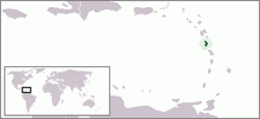
This is a list of amphibians and reptiles found on Dominica, a Caribbean island-nation in the Lesser Antilles. Dominica is one of the few islands in that chain that has retained its original amphibian and reptile fauna over the last 200 years, and reptiles in particular form a significant part of its fauna.[1]
Amphibians
There are four species of amphibians on Dominica, all from the Leptodactylidae family of frogs. Three are native, and one, Eleutherodactylus amplinympha, is endemic to Dominica.
Frogs (Anura)
| Tropical frogs (Leptodactylidae) | |||
|---|---|---|---|
| Species | Common name(s) | Notes | Image |
| Eleutherodactylus amplinympha | Gounouj | Endangered.[2] Endemic. First described in 1994. Most abundant in transition zone between montane rainforest and elfin woodland, but range also extends over broader range of altitudes, coexisting with E. martinicensis. | |
| Eleutherodactylus johnstonei | Lesser Antillean whistling frog, coqui antillano, Johnstone's whistling frog | Least concern. Recently introduced. Widespread throughout the Lesser Antilles. | 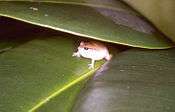 |
| Eleutherodactylus martinicensis | Tink frog, Martinique robber frog | Near threatened. Regional endemic. Abundant in rain forest; uncommon in dry coastal forest. Local populations are being displaced by E. johnstonei along part of the west (Caribbean) coast.[3] |  |
| Leptodactylus fallax | Giant ditch frog, mountain chicken | Critically endangered. Regional endemic. Natural range on the western (Caribbean) side of Dominica from sea level to 400 m elevation. Populations are infected with chytridiomycosis and are in severe decline. Widely eaten in Dominica as a novelty food prior to its legal protection in 2002.[4] | .jpg) |
Reptiles
Two of the four extant orders of reptile are represented on Dominica: Squamata and Testudines. Including marine turtles and introduced species, there are a total of 19 confirmed species of reptiles.
Endemic reptile species include the Dominican anole (Anolis oculatus) and the Dominican ground lizard (Ameiva fuscata). The Dominican blind snake (Typhlops dominicanus or T. d. dominicanus) and the Dominican clouded boa (Boa constrictor nebulosis) may also be designated as endemic, though their status as distinct subspecies is unresolved.
Turtles (Testudines)
| Tortoises (Testudinidae) | |||
|---|---|---|---|
| Species | Common name(s) | Notes | Image |
| Geochelone carbonaria | Red-footed tortoise | Likely recent introduction, though possibly as long ago as Amerindian settlement of Dominica.[5] Rarely seen in the wild. |  |
| Scaly sea turtles (Cheloniidae) | |||
| Species | Common name(s) | Notes | Image |
| Caretta caretta | Loggerhead turtle, channel turtle (local name) | Endangered. Rare in Dominican waters; mainly recorded around Soufriere Bay and from Martinique and Guadeloupe Channels. Not recorded nesting on Dominica. | 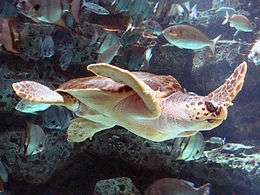 |
| Chelonia mydas | Green turtle | Endangered. Regularly seen in coastal waters; nests on both coasts (though mainly on northern beaches), primarily from June to October. |  |
| Eretmochelys imbricata | Hawksbill turtle | Critically endangered. Regularly seen in coastal waters; nests on both coasts (though mainly on northern beaches), primarily from May to October. | 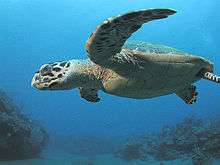 |
| Leathery sea turtles (Dermochelyidae) | |||
| Species | Common name(s) | Notes | Image |
| Dermochelys coriacea | Leatherback turtle | Critically endangered. Fairly rare, mainly recorded from Martinique and Guadeloupe Channels. Nesting recorded from April to June, primarily on south and east (Atlantic) coast beaches. |  |
Lizards and snakes (Squamata)
| Geckos (Gekkonidae) | |||
|---|---|---|---|
| Species | Common name(s) | Notes | Image |
| Hemidactylus mabouia | House gecko | Introduced. Widespread, usually around human populations. | .jpg) |
| Sphaerodactylus fantasticus | Fantastic least gecko | Found at scattered locations along west (Caribbean) coast. Regional endemic; Dominica population has been described as subspecies S. f. fuga. |  |
| Sphaerodactylus vincenti | Vincent's least gecko | Confined to wet high elevations. |  |
| Thecadactylus rapicauda | Tree gecko, turnip-tailed gecko | Widespread |  |
| Iguanas and Anolids (Iguanidae) | |||
| Species | Common name(s) | Notes | Image |
| Anolis cristatellus | Puerto Rican crested anole | Recent introduction (between 1997 and 2002); range limited to southwest (Caribbean) coast around capital of Roseau.[6] |  |
| Anolis oculatus | Dominican anole, eyed anole, tree lizard | Endemic. Four subspecies described (A. o. oculatus, A. o. cabritensis, A. o. montanus, A. o. winstoni) now recognized as ecotypes. Widespread and abundant in all areas below 900 m elevation. South Caribbean ecotype is being displaced by competition from invasive A. cristatellus. |  |
| Iguana delicatissima | Lesser Antillean iguana, West Indian iguana | Vulnerable. Regional endemic. Common on Dominica in certain areas on both east (Atlantic) and west (Caribbean) coasts; occasionally seen in rain forest. |  |
| Whiptails (Teiidae) | |||
| Species | Common name(s) | Notes | Image |
| Ameiva fuscata | Dominican ground lizard, Dominican ameiva | Endemic. Found in dry coastal woodland and associated cultivated areas below 300 m elevation. | 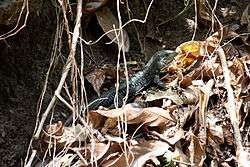 |
| Microteiids (Gymnophthalmidae) | |||
| Species | Common name(s) | Notes | Image |
| Gymnophthalmus underwoodi | Underwood's spectacled tegu | Very similar to G. pleei known to be extant on Dominica; variability of scale counts of collected specimens suggest G. underwoodi (or other Gymnophthalmus species) is also present. Presence confirmed 2008 by Turk, Wyszynski, Powell, and Henderson at Batali Beach[7] | |
| Gymnophthalmus pleei | Martinique spectacled tegu | Officially recorded only at Cabrits National Park and Dominica Botanical Gardens in Roseau, but likely more widespread, and probably with other Gymnophthalmus species present.[8] | |
| Skinks (Scincidae) | |||
| Species | Common name(s) | Notes | Image |
| Mabuya mabouya[9] | Introduced. Regional endemic. Widespread in coastal regions and in cultivated areas at higher elevations.[10] | 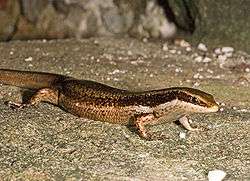 | |
| Worm snakes (Typhlopidae) | |||
| Species | Common name(s) | Notes | Image |
| Typhlops dominicanus | Dominican blind snake, worm snake | Local population either described as endemic species, or endemic subspecies T. d. dominicana, with sister subspecies present on Guadeloupe. | |
| Boas (Boidae) | |||
| Species | Common name(s) | Notes | Image |
| Boa constrictor | Boa constrictor; Dominican clouded boa | Local population sometimes described as endemic subspecies B. c. nebulosa. Widely distributed in Dominica, though vulnerable to persecution, road accidents, and hunting for snake oil derived from its fat. | |
| Colubrids (Colubridae) | |||
| Species | Common name(s) | Notes | Image |
| Alsophis antillensis | Antilles racer, island racer, leeward racer, Dominican racer | Regional endemic. Local population described as endemic subspecies A. a. sibonius or as separate species, A. sibonius. Present everywhere except highest elevations; most abundant in dry woodland on west (Caribbean) coast. |  |
| Liophis juliae | Julia's ground snake, grove snake | Present everywhere except highest elevations. Local population described as endemic subspecies L. j. juliae, with two sister subspecies present on islands of Guadeloupe. | 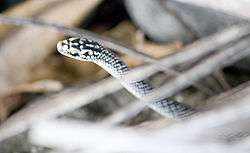 |
Unconfirmed or disputed reptile species
| Species | Common name(s) | Notes | Image |
|---|---|---|---|
| Clelia errabunda | Underwood's Mussurana | A species from Saint Lucia originally recorded on Dominica (as C. clelia) due to a cataloguing error.[11] Reported sightings are most likely melanistic forms of boa.[12] | |
| Sphaerodactylus microlepis | Little-scaled least gecko | Main range is on St. Lucia; only record for presence on Dominica consists of a single specimen with no precise locality.[13] |
Notes
- ↑ Malhotra 2007, p. 177.
- ↑ Conservation status, where available, is from the IUCN Red List and is indicative of the status of the species as a whole, not just populations on Dominica.
- ↑ Malhotra 2007, p. 181.
- ↑ Malhotra 2007, p. 180-81.
- ↑ Malhotra 2007, p. 182. The authors previously doubted there was a viable natural population, attributing its presence to escaped pets. Malhotra 1999, p. 49.
- ↑ Malhotra 2007, pp. 182, 187-88.
- ↑ Turk 2010.
- ↑ Malhotra 2007, p. 183.
- ↑ M. bistriata is instead identified in Malhotra 1999, p. 35, but see Evans 1997, p. 20, and Malhotra 2007, p. 183 (listing M. mabouya as the only skink on Dominica).
- ↑ Distribution of M. mabouya remains uncertain as it is easily confused with G. pleei. Malhotra 2007, p. 183.
- ↑ Malhotra 2007, p. 184.
- ↑ Malhotra 1999, p. 50; Evans 1997, p. 20.
- ↑ Malhotra 2007, p. 185; Malhotra 1999, p. 50. Evans 1997, at p. 18, merely states that its "present Dominican status remains unclear."
References
Note: Species listed above are presumed to be supported by all references unless otherwise cited.
- Evans, Peter G.H.; James, Arlington (1997). Dominica, Nature Island of the Caribbean: Wildlife Checklists. Dominica Ministry of Tourism. pp. 16–21.
- Malhotra, Anita; Thorpe, Roger S.; Hypolite, Eric; James, Arlington (2007). "A report on the status of the herpetofauna of the Commonwealth of Dominica, West Indies". Appl. Herpetol. 4: 177–94. doi:10.1163/157075407780681365.
- Malhotra, Anita; Thorpe, Roger S. (1999). Reptiles & Amphibians of the Eastern Caribbean. Macmillan Education Ltd. ISBN 0-333-69141-5.
- Turk, Patrick; Wyszynski, Natalie; Robert, Powell; Henderson, Robert (2010). "Population densities and water-loss rates of Gymnophthalmus pleii, Gymnophthalmus underwoodi (Gymnophthalmidae), and Sphaerodactylus fantasticus fuga (Sphaerodactylidae) on Dominica, West Indies.". Salamandra. 46.3: 125–130.